Team bonding: Exploring how mandatory and optional activities affect employees
Nulab Staff
December 04, 2023
In 2016, over 1 in 3 employees in the US were millennials, the most represented generation in the labor force. By 2020, millennials are expected to account for half of the US workforce, and by 2025, 75% of the global workforce.
Millennials are already making waves, but analysts say they prize one thing above all else when job searching: an influential company culture. Company culture creates a personality in the workplace by setting clear definitions for the company mission, values, ethics, goals, and expectations.
Having a powerful company culture can establish strong morale, keep employees motivated, and even boost productivity – but it won’t come free. Establishing a genuine corporate culture can’t happen overnight, and it typically involves dedication and team building. With so much emphasis on creating a professional environment people actually enjoy, team-building activities have become common in many workplaces.
For a closer look at team bonding, we surveyed 1,000 full-time employees for their honest feedback. With their bosses out of earshot, we asked respondents how common team bonding was, which activities were the most popular, and how effective or valuable these events were. Read on to see what we uncovered.
Types of team bonding activities and experiences
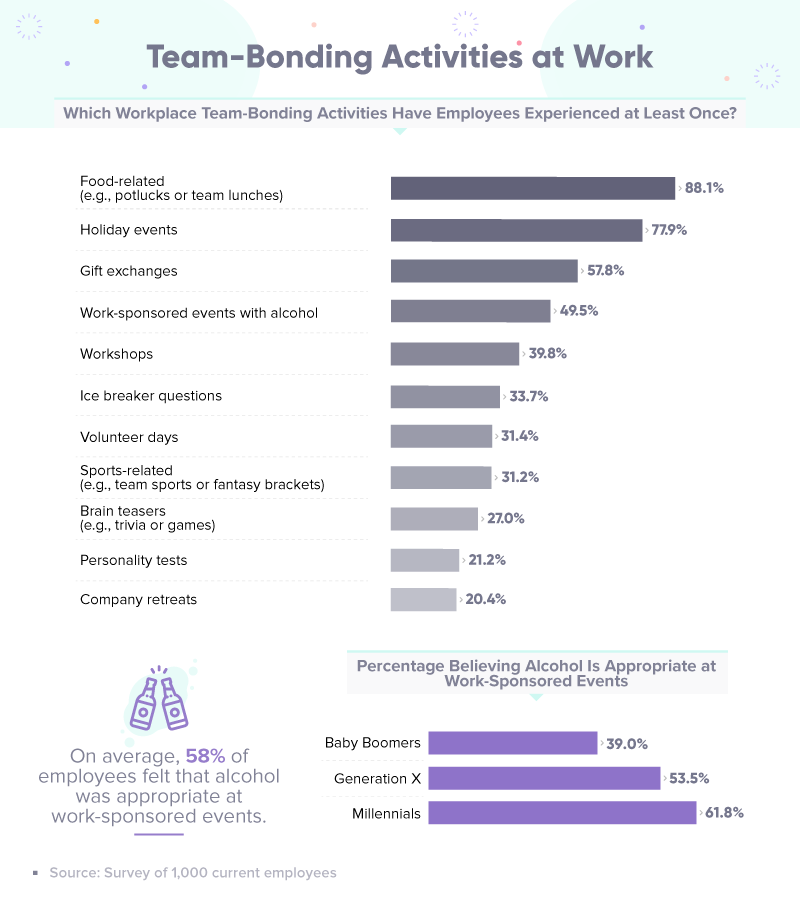
There’s no denying that many employees hate when their companies host mandatory team-building exercises.
After all, employees can handle only so many icebreaker activities and trust-fall exercises. Instead, experts suggest companies look at more innovative ideas like game days, scavenger hunts, and “desert island” questionnaires (where participants identify the items they’d bring with them in various categories if ever stranded in an uninhabited location) to help employees bond and build better communication skills and trust.
When asked about team bonding activities they experienced at least once, 88% of employees said they attended food-related events (like potlucks or team lunches), followed by holiday events (78%), gift exchanges (58%), and work-sponsored activities where alcohol was involved (50%). Well-stocked refrigerators may be a staple in Silicon Valley offices, but they can be a cost-effective solution for bringing people together and may even help promote healthier eating habits.
While 62% of millennials agreed alcohol was appropriate at work-sponsored team events, older employees (nearly 54% of Gen Xers and 39% of baby boomers) were less comfortable with this activity.
Frequency of team bonding events
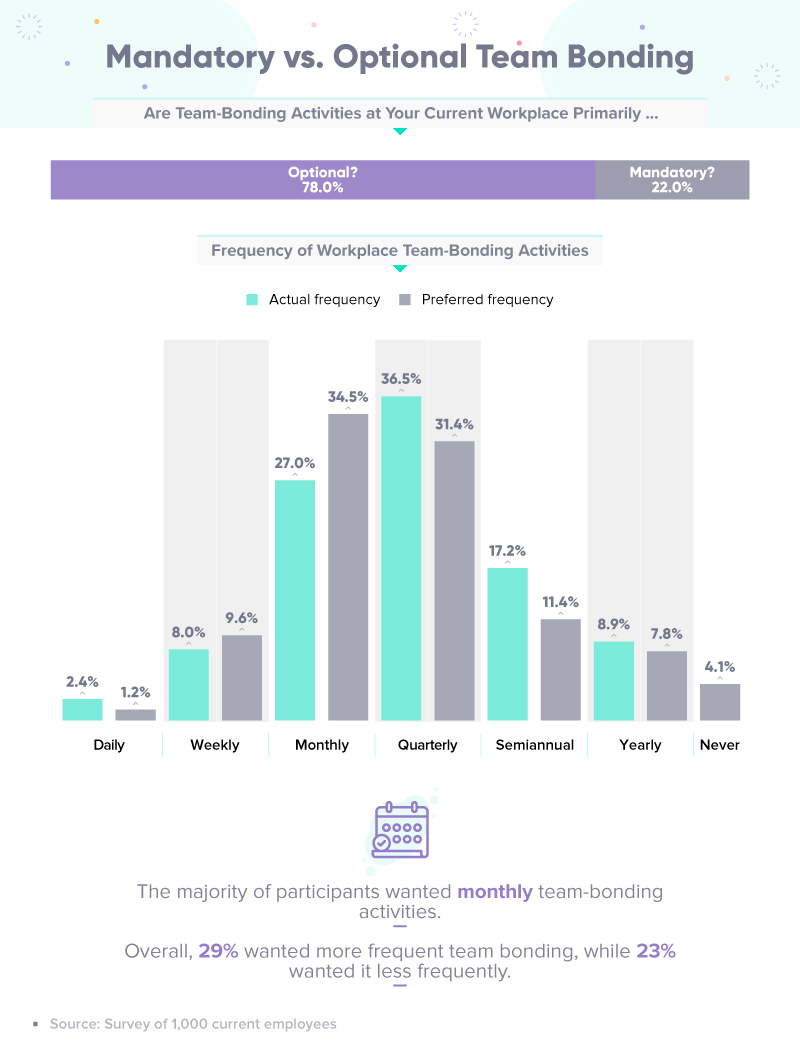
One study found that over half of employees spent more time with their “work families” than their actual families. While that time around co-workers may deepen some bonds, it can make employees less inclined toward voluntary work events.
Seventy-eight percent of respondents said team bonding events at their current workplace were voluntary, while 22% said they were mandatory. And while almost 35% of people wished team bonding activities were offered monthly, they more often occurred quarterly (nearly 37%). Another 1 in 10 survey respondents wished team bonding was available weekly.
Best team bonding activities
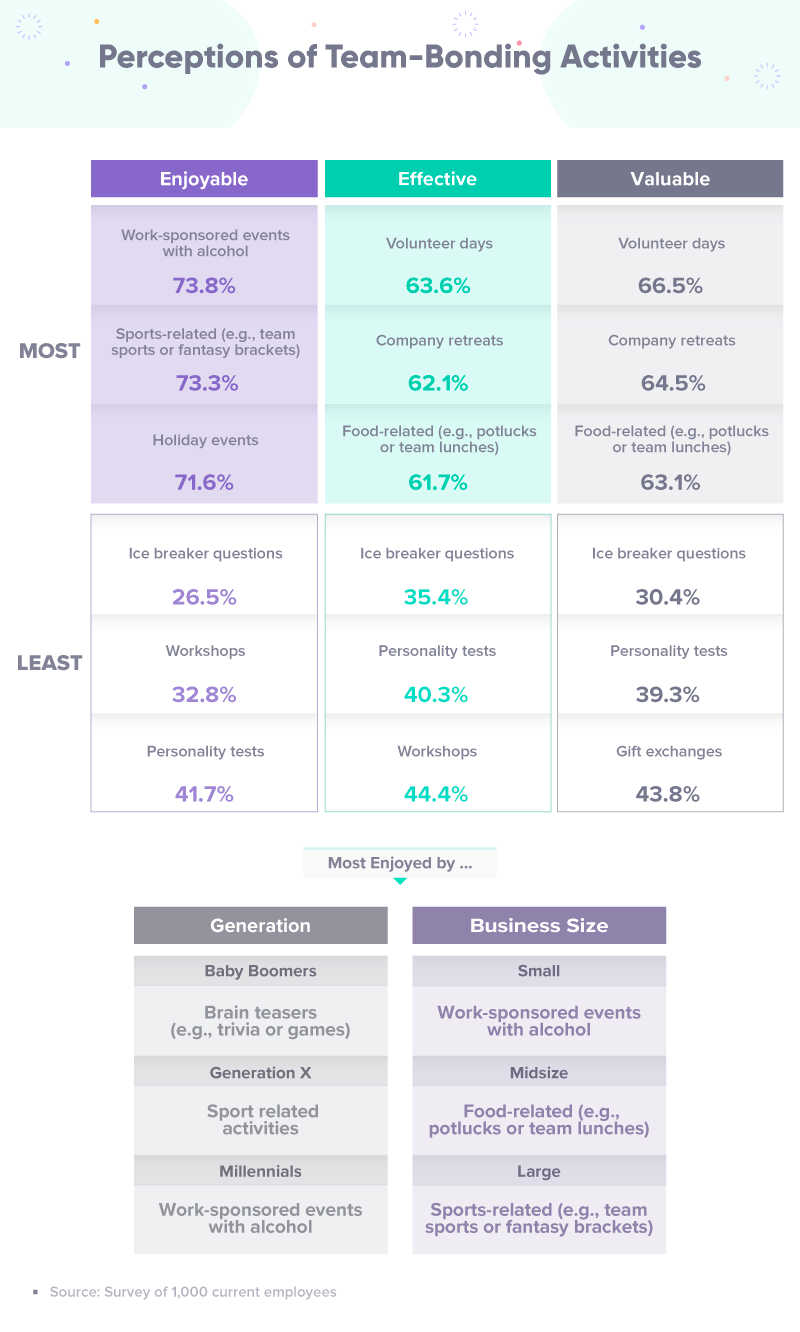
Whether your company hosts team-building events quarterly or every other Friday, it’s fair to admit that not all bonding activities are created equal. Some company-sponsored events may be exciting, while others may seem like unnecessary work meetings.
If you’re hosting a team-building exercise, there’s one activity you might want to steer clear of: icebreaker questions. Icebreakers were considered the least enjoyable, effective, and valuable of all bonding exercises.
Instead, employees typically enjoyed work-sponsored activities with alcohol (74%), sports-related programs (73%), and holiday events (almost 72%). Volunteer days were also considered the most effective (nearly 64%) and valuable (over 66%). One study found an effective volunteer prograisn’t’t just beneficial for creating better employee relationships – it can also promote employee retention, saving companies thousands of dollars by decreasing turnover.
Who’s participating and who’s not
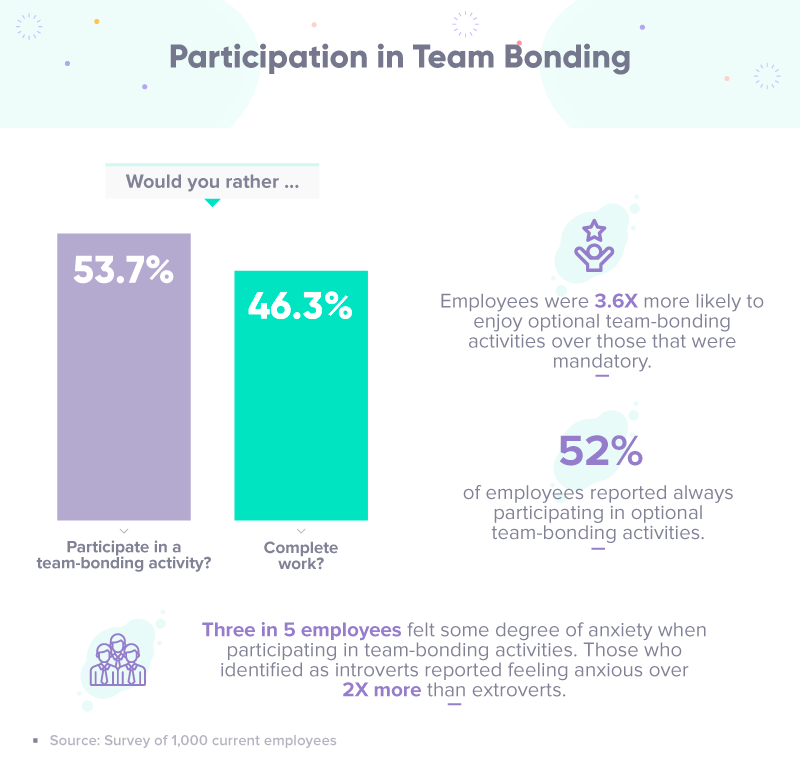
Like positive company culture, building effective relationships with colleagues isn’t something that happens overnight. However, there are plenty of options for establishing effective interpersonal relationships with co-workers, including helping others achieve success, sharing credit for your accomplishments, being transparent, and monitoring your nonverbal communication.
Bonding activities were 3.6 times more likely to be enjoyed when they were optional rather than mandatory. When given a choice, more than half of employees would opt for team-building events, although 3 in 5 experienced anxiety during these activities.
Impacts of team-building
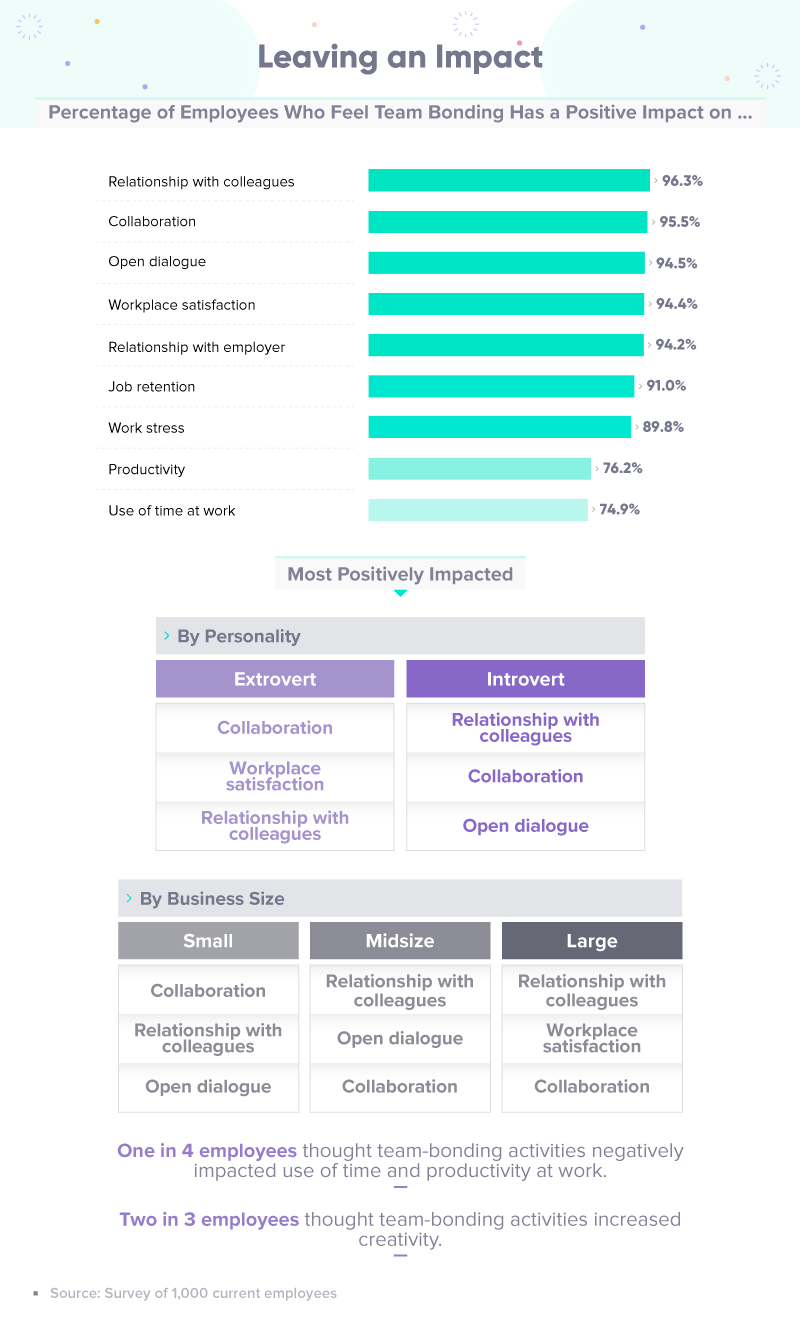
When finding value in team-building exercises, the effects may extend much deeper than relationships between co-workers. While 96% of respondents said their relationship with colleagues was positively impacted by team bonding, collaboration (nearly 96%), open dialogue (over 94%), workplace satisfaction (94%), and employee-employer relationships (94%) weren’t far behind.
How well (and to what extent) your company benefits from team-building efforts may depend on the size of the group and the personalities of the employees. While extroverts were more likely to experience a positive impact on their collaboration and workplace satisfaction, introverts felt more comfortable building relationships and collaborating with their colleagues. Two in 3 respondents suggested team bonding exercises improved creativity, which can help promote better problem-solving and general workplace efficiency.
Fostering remote team unity: Engaging online group activities
In the era of remote work, where teams may be dispersed across various locations, the importance of team bonding remains undiminished. While traditional in-person activities may be challenging, online group activities offer an excellent avenue for fostering camaraderie and collaboration among remote teams.
1. Virtual Game Days
Embrace the digital realm with virtual game days. Online games, quizzes, or collaborative challenges can bring team members together in a fun and interactive way, transcending geographical barriers.
2. Digital Scavenger Hunts
Transform the classic scavenger hunt into a digital adventure. Participants can search for virtual items or engage in themed challenges, promoting teamwork and problem-solving skills.
3. “Desert Island” Questionnaire
Adapt the traditional “desert island” scenario into a virtual questionnaire. Team members can share their preferences and choices, providing insights into their personalities and promoting a sense of connection.
4. Online Volunteer Initiatives
Encourage team members to participate in virtual volunteer activities. Whether it’s contributing to a digital charity event or collectively supporting a cause, virtual volunteering fosters a shared sense of purpose.
Embracing collaboration software for remote teams
As remote teams navigate the challenges of physical distance, collaboration software becomes a vital ally. Nulab’s tools not only simplify task management and project planning but also facilitate seamless collaboration across diverse teams.
In the evolving landscape of work, online group activities coupled with advanced collaboration tools redefine how remote teams bond and collaborate. By leveraging these innovative approaches, companies can create a virtual environment that transcends physical limitations, fostering a strong and united remote team.
Choosing wisely
Quality team-building activities benefit just about everyone: individuals, their relationships with colleagues, and even the company’s success. But the keyword might be “quality.” Common team bonding efforts like icebreakers and potlucks may not help anyone and may even seem like an unnecessary use of company time. Instead, employees preferred volunteering and getting to commune with one another over alcohol to build rapport.
Now, it’s your turn to embark on a journey of team bonding. Whether you opt for virtual game days, physical scavenger hunts, insightful questionnaires, or engaging in volunteer initiatives, the possibilities are endless.
Remember, the true magic of team bonding lies in the shared experiences, laughter, and challenges that bring team members closer. So, take the plunge, explore new avenues, and witness the transformation as your team evolves into a cohesive force. Unleash the power of team bonding – your team’s success story begins with a shared adventure!
Methodology and limitations
These data were curated via survey usiAmazon’sn’s Mechanical Turk platform. Participants had to be current employees and in-office/in-house at their current workplace. They also had to have participated in a team bonding activity at least once. There were a total of 1,000 participants.
Percentage of participants in each industry:
- Education – 17.1%
- Medical and Health Care – 14.0%
- Finance and Insurance – 12.2%
- Wholesale and Retail – 11.5%
- Technology – 10.1%
- Hotel, Food Services, and Hospitality – 7.3%
- Government and Public Administration – 6.6%
- Manufacturing – 6.2%
- Information Services and Data Processing – 5.7%
- Arts, Entertainment, and Recreation – 5.3%
- Marketing and Advertising – 4.2%
65.4% of participants described themselves as introverted, and 34.6% described themselves as extroverted. 35.9% of participants worked at a small business, 36.2% at a midsize business, and 27.8% at a large business. The youngest participant was 18, and the oldest was 87, with a mean of 36.2 and a standard deviation of 10.2.
Exaggeration and selective memory are potential issues that can arise because the data rely on self-reported information.
The data were not statistically tested. Due to the exploratory nature of this study, future research could look into more granular data regarding the specific activities in different work environments.
Sources
- https://www.pewresearch.org/fact-tank/2018/04/11/millennials-largest-generation-us-labor-force/
- https://www.inc.com/peter-economy/the-millennial-workplace-of-future-is-almost-here-these-3-things-are-about-to-change-big-time.html
- https://www.forbes.com/sites/larryalton/2017/02/17/why-corporate-culture-is-becoming-even-more-important/#5c31f9e969da
- https://www.thebalancecareers.com/what-is-company-culture-2062000
- https://hbr.org/2017/06/changing-company-culture-requires-a-movement-not-a-mandate
- https://www.forbes.com/sites/brianscudamore/2016/03/09/why-team-building-is-the-most-important-investment-youll-make/#a3220a1617fc
- https://www.entrepreneur.com/article/306246
- https://www.inc.com/chirag-kulkarni/3-reasons-why-investing-in-company-meals-will-boost-your-bottom-line.html
- https://www.cnbc.com/2017/12/14/this-study-identified-the-5-people-that-make-up-a-work-family.html
- https://www.charities.org/news/business-case-employee-volunteer-skills-giving-programs
- https://www.thebalancecareers.com/developing-effective-work-relationships-1919386
- https://www.allbusiness.com/the-importance-of-creativity-in-the-workplace-24566-1.html
Fair Use Statement
As tasty as another potluck might sound, quality time with your co-workers could prove much more beneficial. Spread the word by sharing the results of this study for any non-commercial use with a link back to this page to credit to our team.
This post was originally published on August 5, 2019, and updated most recently on December 4, 2023.


